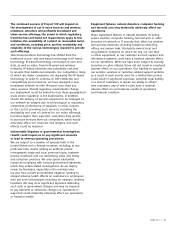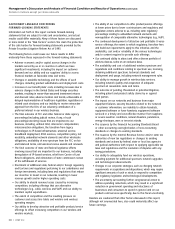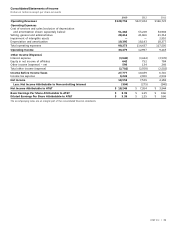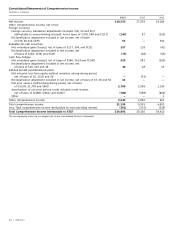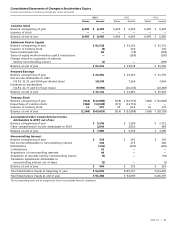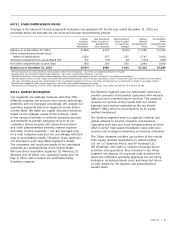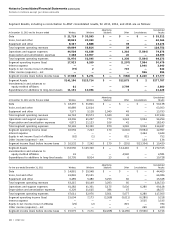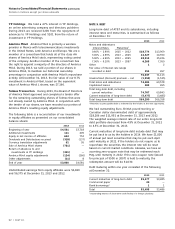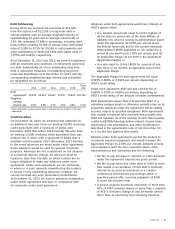AT&T Wireless 2013 Annual Report Download - page 47
Download and view the complete annual report
Please find page 47 of the 2013 AT&T Wireless annual report below. You can navigate through the pages in the report by either clicking on the pages listed below, or by using the keyword search tool below to find specific information within the annual report.
AT&T Inc. | 45
Software Costs It is our policy to capitalize certain
costs incurred in connection with developing or obtaining
internal-use software. Capitalized software costs are
included in “Property, Plant and Equipment” on our
consolidated balance sheets and are primarily amortized
over a three-year period. In addition, there is certain
network software that allows the equipment to provide
the features and functions unique to the AT&T network,
which we include in the cost of the equipment categories
for financial reporting purposes.
Goodwill and Other Intangible Assets AT&T has
four major classes of intangible assets: goodwill, Federal
Communications Commission (FCC) licenses, other
indefinite-lived intangible assets, made up predominately
of the AT&T brand, and various other finite-lived
intangible assets (see Note 7).
Goodwill represents the excess of consideration paid
over the fair value of net assets acquired in business
combinations. FCC licenses provide us with the exclusive
right to utilize certain radio frequency spectrum to
provide wireless communications services. While FCC
licenses are issued for a fixed period of time (generally
10 years), renewals of FCC licenses have occurred
routinely and at nominal cost. Moreover, we have
determined that there are currently no legal, regulatory,
contractual, competitive, economic or other factors that
limit the useful lives of our FCC licenses. We acquired the
rights to the AT&T and other brand names in previous
acquisitions. We have the effective ability to retain these
exclusive rights permanently at a nominal cost.
Goodwill, FCC licenses and other indefinite-lived intangible
assets are not amortized but are tested at least annually
for impairment. The testing is performed on the value as of
October 1 each year, and compares the book value of the
assets to their fair value. Goodwill is tested by comparing
the book value of each reporting unit, deemed to be our
principal operating segments (Wireless and Wireline), to
the fair value of those reporting units calculated under a
discounted cash flow approach as well as a market multiple
approach. FCC licenses are tested for impairment on an
aggregate basis, consistent with the management of the
business on a national scope. We perform our test of the
fair values of FCC licenses using a discounted cash flow
approach. Brand names are tested by comparing the book
value to a fair value calculated using a discounted cash
flow approach on a presumed royalty rate derived from
the revenues related to the brand name. The fair value
measurements used are considered Level 3 under the Fair
Value Measurement and Disclosure framework (see Note 10).
Intangible assets that have finite useful lives are
amortized over their useful lives (see Note 7). Customer
lists and relationships are amortized using primarily the
write-offs, net of recoveries, as well as an analysis of the
aged accounts receivable balances with allowances
generally increasing as the receivable ages. Accounts
receivable may be fully reserved for when specific
collection issues are known to exist, such as pending
bankruptcy or catastrophes.
Inventory Inventories, which are included in “Other
current assets” on our consolidated balance sheets,
were $1,148 at December 31, 2013, and $1,036 at
December 31, 2012. Wireless devices and accessories,
which are valued at the lower of cost or market
(determined using current replacement cost) were $1,031
at December 31, 2013, and $888 at December 31, 2012.
Property, Plant and Equipment Property, plant and
equipment is stated at cost, except for assets acquired using
acquisition accounting, which are initially recorded at fair
value (see Note 6). The balance as of December 31, 2013,
excluded amounts classified as held for sale (see Note 5).
The cost of additions and substantial improvements to
property, plant and equipment is capitalized, and includes
internal compensation costs for these projects; however,
noncash actuarial gains or losses included in compensation
costs are excluded from our capital expenditures reported
on the consolidated statements of cash flows. The cost of
maintenance and repairs of property, plant and equipment
is charged to operating expenses. Property, plant and
equipment costs are depreciated using straight-line methods
over their estimated economic lives. Certain subsidiaries
follow composite group depreciation methodology.
Accordingly, when a portion of their depreciable property,
plant and equipment is retired in the ordinary course of
business, the gross book value is reclassified to accumulated
depreciation, and no gain or loss is recognized on the
disposition of these assets.
Property, plant and equipment is reviewed for recoverability
whenever events or changes in circumstances indicate that
the carrying amount may not be recoverable. We recognize
an impairment loss when the carrying amount of a long-
lived asset is not recoverable. The carrying amount of a
long-lived asset is not recoverable if it exceeds the sum
of the undiscounted cash flows expected to result from
the use and eventual disposition of the asset.
The fair value of a liability for an asset retirement obligation
is recorded in the period in which it is incurred if a
reasonable estimate of fair value can be made. In periods
subsequent to initial measurement, we recognize period-to-
period changes in the liability resulting from the passage
of time and revisions to either the timing or the amount of
the original estimate. The increase in the carrying value of
the associated long-lived asset is depreciated over the
corresponding estimated economic life.




